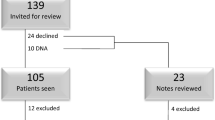Abstract
This study was performed to evaluate the efficacy and complications of the posterior intravaginal slingplasty (IVS). A retrospective chart review was performed. Ninety IVS procedures were performed from January 2004 to June 2005. The group consisted of predominantly nonsmoking, Caucasian, postmenopausal women with a median age of 62 years and a median parity of 3. The mean follow-up was 33 ± 23.2 weeks with a median of 31.9 weeks. There were no intraoperative bladder, bowel, or vascular injuries. Overall, 11 out of 90 patients developed recurrent or de novo prolapse; 4.4% of these had recurrent apical prolapse. There was a 17.8% incidence of mesh erosion. Only 1 of the 11 patients with recurrent prolapse had concomitant mesh erosion. The procedure demonstrated an unacceptably high erosion rate. The adoption of newer mesh techniques based on the slingplasty concept or the use of the multifilament polypropylene tape should be scrutinized.

Similar content being viewed by others
References
Olsen AL, Smith VJ, Bergstrom JO, Collin JC, Clark AL (1997) Epidemiology of surgically managed pelvic organ prolapse and urinary incontinence. Obstet Gynecol 89:501–506
DeLancey JO (1992) Anatomic aspects of vaginal eversion after hysterectomy. Am J Obstet Gynecol 166:1717–1724
Maher CF et al (2004) Abdominal sacral colpopexy or vaginal sacrospinous colpopexy for vaginal vault prolapse: a prospective randomized study. Am J Obstet Gynecol 190:20–26
Benson J et al (1996) Vaginal versus abdominal reconstructive surgery for the treatment of pelvic support defects: a prospective randomized study with long-term outcome evaluation. Am J Obstet Gynecol 175:1418–1422
Paraiso MF et al (1996) Pelvic support defects and visceral and sexual function in women Treated with sacrospinous ligament suspension and pelvic reconstruction. Am J Obstet Gynecol 175:1423–1431
Shull BL et al (1992) Preoperative and postoperative analysis of site-specific pelvic support defects in 81 women treated with sacrospinous ligament suspension and pelvic reconstruction. Am J Obstet Gynecol 166:1764–1771
Holley RL et al (1995) Recurrent pelvic support defects after sacrospinous ligament fixation for vaginal vault prolapse. J Am Coll Surg 180:444–448
Petros PE (2001) Vault Prolapse II: restoration of dynamic vaginal supports by infracoccygeal sacropexy, an axial day-case vaginal procedure. Int Urogynecol J 12:296–303
Baden WF, Walker TA (1972) Genesis of the vaginal profile: a correlated classification of vaginal relaxation. Clin Obstet Gynecol 15:1048–1054
Farnsworth BN (2002) Posterior intravaginal slingplasty (infracoccygeal sacropexy) for severe posthysterectomy vaginal vault prolapse—a preliminary report on efficacy and safety. Int Urogynecol J 13:4–8
Jordaan DJ, Prollius A, Cronje HS, Nel M (2006) Posterior intravaginal slingplasty for vaginal prolapse. Int Urogynecol J 17:326–329
Neuman M, Lavy Y (2007) Posterior intra-vaginal slingplasty for the treatment of vaginal apex prolapse: medium-term results of 140 operations with a novel procedure. Eur J Obstet Gynecol Reprod Biol DOI 10.1016/j.ejogrb.2006.07.035
Biertho I, Dallemagne B, Dewandre JM, Markiewicz S, Monami B, Wahlen C, Weerts J, Jehaes C (2004) Intravaginal slingplasty: short term results. Acta Chir Belg 104(6):700–704
Yildirim A, Basok EK, Gulpinar T, Gurbuz C, Zemheri E, Tokuc R (2005) Tissue reactions of 5 sling materials and tissue material detachment strength of 4 synthetic mesh materials in a rabbit model. J Urol 174(5):2037–2040
Siegel AL, Kim M, Goldstein M, Levey S, Ilbeigi P (2005) High incidence of vaginal mesh erosion using the intravaginal slingplasty sling. J Urol 174:1308–1311
Rane A, Lim YN, Withey G, Muller R (2004) Magnetic resonance imaging findings following three different vaginal vault prolapse repair procedure: a randomized study. Aust N Z J Obstet Gynaecol 44:135–139
Sivaslioglu AA, Unlubilgin E, Dolen I (2007) The multifilament polypropylene tape erosion trouble: tape structure vs surgical technique. Which one is the cause? Int Urogynecol J Pelvic Floor Dysfunct DOI 10.1007/s00192-007-0456-z
Conflicts of interest
None.
Author information
Authors and Affiliations
Corresponding author
Rights and permissions
About this article
Cite this article
Luck, A.M., Steele, A.C., Leong, F.C. et al. Short-term efficacy and complications of posterior intravaginal slingplasty. Int Urogynecol J 19, 795–799 (2008). https://doi.org/10.1007/s00192-007-0527-1
Received:
Accepted:
Published:
Issue Date:
DOI: https://doi.org/10.1007/s00192-007-0527-1




